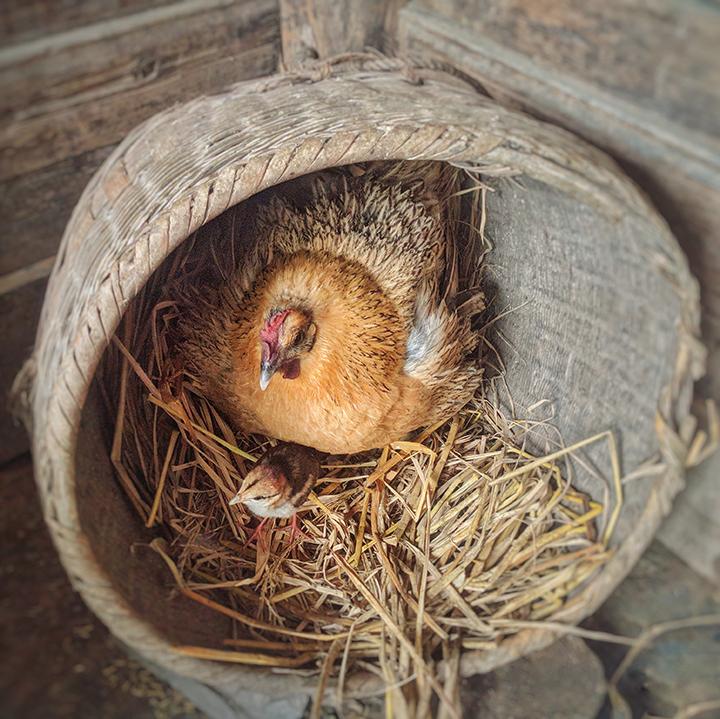 |
|
| Issue #65 • September/October, 2000 |
Every day around the home place brings with it many new experiences. The number of projects, chores, repairs, and other tasks often seem endless. With those jobs come little problems or inconveniences which homesteaders often take delight in solving, working out, or working around.

If you have much fence at all, you need a good fencing box. This one was made from scraps.

Lockable shelf constructed between wall studs in the tool shed

Screen door made by cutting out wood panel and adding chicken wire.

his old mailbox is posted at the entrance of our garden, keeping hand tools ready at all times.

5-gallon bucket nest boxes. The pole in front of the nests provides a landing spot for the hens.
In fact, homesteaders are notorious for coming up with innovative ideas for making the workload easier. A bit of time spent in the workshop can result in a lot of time saved when working. Little conveniences and contrivances here and there go a long way towards increasing the productivity and enjoyment on the small farm and homestead. Here are a few simple projects that I have found to be very helpful on our own place.
Fencing box
If you have fence around or on your property, then you need some type of toolbox for toting all the necessary fencing tools needed to do construction or make repairs. In the photograph, my own fencing toolbox is shown. It seems that every such tool-toter I’ve ever seen is of a different size, of different materials, or of a different style. What that says to me is that the maker of the box simply used what he had on hand and on his mind to make the box that would best suit his own purposes.
The box shown was simply made of scrap plywood. The handle came from a broken rake handle. The box was loosely designed to hold containers and tools needed for fencing jobs around our place. The measurements were made so that some common containers would fit in the box. On one end, you can see the bottom two-thirds or so of a plastic anti-freeze jug. It’s handy for holding spike nails, balls of string, spools of wire, and so on. In the center and opposite end of the box, I partitioned off the main box to accommodate the cut off sections of plastic oil bottles. They are very handy for holding various lengths of fence staples, nails, pencils, small tools, etc. The containers were created very quickly and easily by clamping a guide board to the table of my bandsaw and cutting off the top quarter or so of each bottle. The resulting containers were cut cleanly and uniformly.
Parts containers
Incidentally, in my workshop, I have constructed shelves and filled them with several of the plastic containers described above. They contain nuts, bolts, screws and nails of various or graduated sizes as well as other hardware. Those particular containers are made from the white or gray plastic oil bottles and labeled with a black permanent marker to easily identify the contents. They have greatly helped to organize the workshop collection of hardware and fasteners. Consider asking your friends to save their oil bottles for a while and you will soon have a good supply to work with. For larger parts, consider using those used anti-freeze jugs. They come in a shape similar to the oil bottles, only larger. They may be cut in the same manner as the oil bottles and labeled to indicate the contents.
Toolshed storage container
In our toolshed, we needed a place to secure some medications, fluids, wasp spray, and the few toxic chemicals that we use around the place. That was easily accomplished by using some scrap 1×4’s and creating some shelves between the studs of the building. Next, I added a door made from a piece of plywood, attaching it with some used hinges. A hasp completed the project and provided some security from young inquiring minds.
Garden tool box
In the garden, we often find a few odd minutes to do some weeding here or there. What we couldn’t always find were the hand tools. That problem was remedied by recycling an old mailbox which provided a convenient and dry spot to store garden hand tools. A coat of paint and some lettering, and the box was put in place. Since we pass the box whenever we enter or leave the garden, it’s a simple matter to keep the tools where they belong and find them there when we need them.
In the chicken house
Over in the chicken house, recycling again came in handy. When the structure was built, I used a door I had gotten free from an old house that was being demolished. As is often the case, when using any old or recycled materials, measurements are often odd and unique. The door was not a standard size, so I simply constructed the door opening to fit the door. With a saber saw, I removed the door’s plywood panel (saving it for later projects) and added chicken wire in its place. This provided added ventilation during the summer. The opening is covered with clear plastic during the cold winter months.
In the photograph, you can see through the chicken wire, the five-gallon buckets, which we made into good nest boxes. I traced the inside bucket edge onto a scrap board and cut the crescent shape with the saber saw. It was added to the bucket with small nails and helps to keep straw and eggs in the nest box. A friend did the same thing more simply by merely cutting off the suitable portion of the bucket lid and using the remainder in the same way I did the wooden wedge.
Bottle-calf feeder
In our area, and most areas where dairy operations exist, the seasonal abundance of male dairy calves creates a good opportunity for the homesteader or small farmer to acquire some good animals at very reasonable prices. This past season, some of the neighboring Amish farmers were almost giving calves away. It was common to pick up calves under a week old for $10 to $30. Regardless of how you end up with your animals, the feeding of more than a couple of calves is quite a chore.

Bottle-calf feeder. Four calves can be pretty frisky, so hang on.
Another project that came from the scrap pile helped us to solve the problem of feeding four hungry and lively bottle-calves at the same time. As you can see in the photograph, the bottle holder allows one person to feed all four calves at once. Again, the project depends upon the materials which you have on hand, but do try to get at least a foot or so between the bottles. In our experience, the top board is necessary to hold the bottles in place. Hungry calves can get pretty aggressive as they empty the bottles. The board is just a scrap of 1×4 and is attached with an old hinge on one end and a springloaded hook and eye on the other. The kids really enjoyed feeding those calves and rapidly became a help at feeding time.
Heated paint storage
I needed a way to keep paints, stains, caulking, and other such compounds from freezing during the cold of winter. After experimenting by trying to add rigid foam insulation to a wooden cabinet, I was left scratching my head in frustration. Then, I decided that I could solve the problem by recycling an old refrigerator and making it into a heated storage cabinet. After all, it was large enough to hold just about all of my paints and such, it already had electrical power to it, and best of all it was already insulated.

This old refrigerator is now a heated storage locker for paints, etc. A small light provides enough heat in the insulated compartment to keep paint and other fluids from freezing.
The wiring was pretty simple for this project. After removing the necessary panels, the socket holding the little appliance bulb was wired directly to the power cord. This made the light socket “hot” all the time. Basically, the switch was just removed from the circuit. I soon found that an appliance bulb created far too much heat in the cabinet. So I journeyed to the local hardware emporium and purchased a screw-in device that creates a standard plug-in receptacle from a light bulb socket. Then, I plugged in an ordinary night-light. With a standard 7-watt bulb, the heat generated is sufficient to keep the paints and fluids from freezing. Experiment with your own to see what works for you. Something in the 7-25 watt range should be sufficient. If you are uncomfortable working with electrical appliances, try to bribe, coerce, or otherwise enlist the help of a knowledgeable friend. The main shelves should provide plenty of room for your freezable fluids, and spray paint cans fit nicely in the door shelves. A friend who does some welding says that the heated cabinet should work well to store welding rods in, providing uniform heat and a good dry environment.
Chest freezer feed bin
Once those calves we were bottle-feeding got big enough to go on grain, we needed a good, dry, critter-proof place to store feed. After thinking about it for a bit, I decided that an old dead chest freezer would fill the bill. I merely removed the light, bin dividers and any hardware that might snag on a feed sack, then set the new feed bin in place. It has been serving nicely now for several years and can keep about 500 pounds of feed clean, dry, and vermin-free.
I’d say that projects like these result from three primary motivators. First, we never seem to have enough money to run out and buy all the things we needif the item we need exists in the first place. Second, the desire to recycle and reuse potentially discarded items helps us all in the end. Third, homesteaders are doers. I enjoy trying to sort out and solve these little problems that pop up. If you enjoy doing that, I’d bet that you have your own list of problem-solvers and work-savers that you have come up with over the years.














